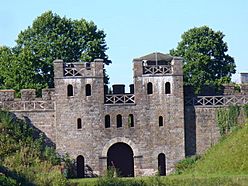Cardiff Roman Fort facts for kids
Quick facts for kids Cardiff Roman Fort |
|
|---|---|

Reconstructed Roman gateway to Cardiff castle
|
|
| Place in the Roman world | |
| Province | Britannia |
| Location | |
| Coordinates | 51°28′56″N 3°10′53″W / 51.4822°N 3.1814°W |
| Town | Cardiff |
| Country | Wales |
| Reference | |
| UK-OSNG reference | ST180765 |
The Cardiff Roman Fort was an ancient Roman army base. It was located on the coast in a Roman area called Britannia Superior. This area included what we now call Wales. We don't know its exact Roman name. Today, parts of the fort are still visible inside Cardiff Castle in the city of Cardiff, the capital of Wales.
Contents
What Was Its Name?
Historians are not completely sure what the Romans called this fort. It might have been named Tamium. This name appears in an old Roman book called the Ravenna Cosmography. However, Tamium might have been the name of the River Taff instead. Another possible name is Bovium. This name comes from another Roman travel guide, the Antonine Itinerary.
Early Roman Forts
Before the main stone fort was built, there were at least two earlier Roman forts on this same spot.
First Fort: Around AD 55
The very first fort was likely a temporary camp. Roman soldiers probably built it around AD 55. This was during their attempts to conquer the local Silures tribe.
Second Fort: Around AD 75
After some time, the first fort was abandoned. About twenty years later, around AD 75, a new, smaller fort was built. This second fort was probably used by Roman auxiliary troops. These were soldiers who were not full Roman citizens. A small civilian village, called a vicus, also grew up nearby. This fort and village were likely used until the time of Emperor Hadrian.
Later Civilian Use
From the late 100s to the mid-200s AD, the site changed. It was no longer a military fort. Instead, people built wooden buildings there. These buildings were used for working with iron.
The Carausian Shore Fort
Around the year 290 AD, a much larger and stronger fort was built. This was a "shore fort," designed to protect the coast. It covered about 9 acres (3.57 hectares). It was similar to the very well-preserved Roman fort at Portchester in England.
Fort's Purpose and Features
The walls of this new fort were very thick, about ten feet wide. Its location was important. It helped the Romans control who could travel up the River Severn. There might have also been watchtowers on the cliffs nearby. These cliffs have since worn away.
Why Was It Built?
This strong fort was likely built by Emperor Carausius. He was trying to defend against more and more raids from Irish raiders. The soldiers and sailors stationed here eventually moved away around 370 AD.
Post-Roman Legends
After the Romans left, the fort became a ruin. It appears in old stories and legends. In the medieval romance of Geraint and Enid, the ruined fort is mentioned. It is described as the home of 'King Ynwyl'. This story is part of the collection known as the Mabinogion. Geraint was possibly a king from the 400s AD in a place called Dumnonia.
Images for kids
-
Portchester (Portus Adurni) is the best preserved Roman fort north of the Alps. The D-shaped towers are typical of 3rd-century of Roman forts.




